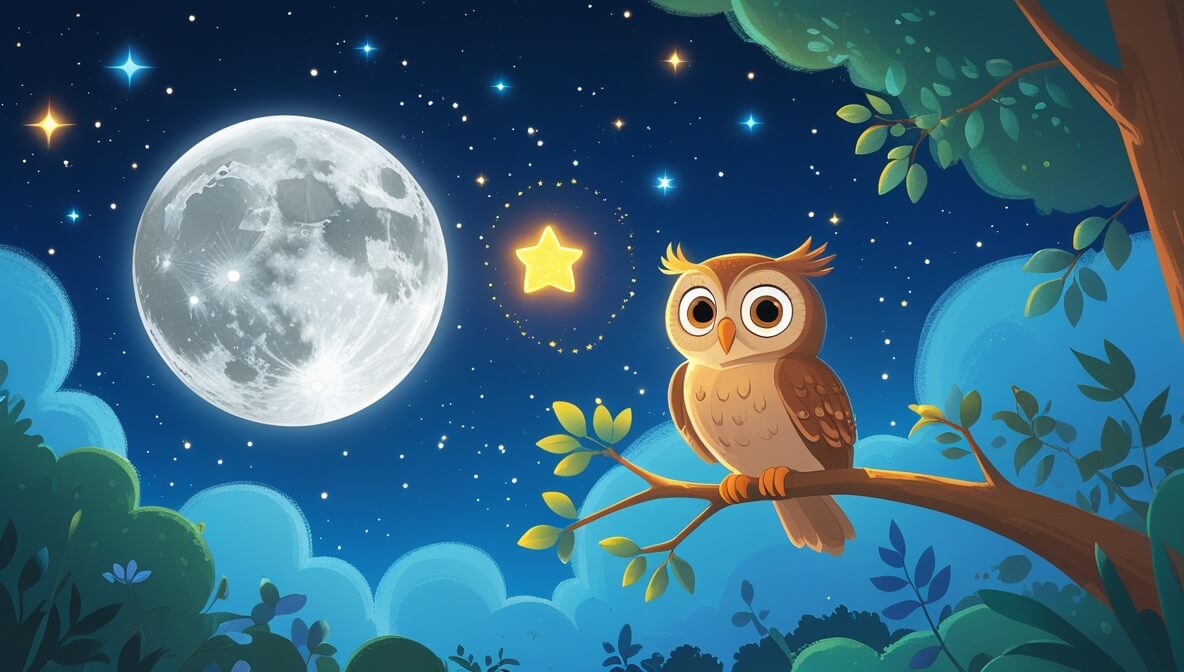Little Ollie Owl embarks on a magical night-time adventure to discover the secret of the glowing moon. Along the way, he makes new friends and learns the importance of curiosity and friendship.
Age Recommendation
0 – 4 years
Characters
Characters:
- Ollie Owl (a curious and brave little owl)
- Luna Firefly (a sparkling firefly who loves to explore)
- Twinkle Star (a friendly star who guides Ollie)
Story
One night, as the moon shone brightly, little Ollie Owl sat on a branch, his eyes wide open. He *wondered* why the moon *glowed* so beautifully. “I want to find out the moon’s secret!” he declared.
A sparkling adventure begins
Ollie spread his wings and flew silently into the night. Suddenly, a tiny light danced around him. “Hello, I’m Luna Firefly,” chirped the light. “Where are you going?” Ollie smiled and said, “I’m going to find the moon’s secret. Would you come with me?” Luna winked and replied, “Of course, let’s go together!”
Meeting Twinkle Star
As they flew higher, they met Twinkle Star, who twinkled brightly in the sky. “Hello, Ollie and Luna! Do you need any help?” asked Twinkle. “Yes, please! We want to know why the moon glows,” Ollie said. Twinkle smiled and said, “Follow me!”
The moon’s magical glow
With Twinkle Star guiding them, they flew closer to the moon. The moon whispered, “My secret is the magic of friends like you who keep the night bright and beautiful.” Ollie and Luna beamed with happiness. They realized that the moon’s glow was a *reflection* of their own friendship.
The end.
Moral of the Story
The story teaches that *friendship* and *curiosity* make the world a brighter place. Exploring together can reveal magical secrets and bring joy.
Questions to Think About
- Why did Ollie want to find out the moon’s secret?
- How did Luna and Twinkle help Ollie?
- What did the moon reveal to Ollie and his friends?
- How do you think Ollie felt about his journey?
- What can you learn from Ollie’s adventure?
Do You Know
- The moon doesn’t really glow on its own; it reflects the light from the sun.
- Fireflies light up using a natural process called bioluminescence, which helps them communicate.
Word Explorer
- Glow: To shine with a soft light.
- Curiosity: A strong desire to learn or know something.
- Reflect: To send back light from a surface.
Emotions in the Story
- Curiosity: Felt by Ollie when he wanted to know the moon’s secret.
- Friendship: When Luna decided to join Ollie on his adventure.
- Happiness: When the moon revealed its secret to Ollie and his friends.
Color Your Scene
Imagine the moment when Ollie, Luna, and Twinkle reach the glowing moon. Draw the brilliant moon surrounded by twinkling stars and fluttering fireflies. Use beautiful blues, whites, and yellows to make your scene sparkle.
Parents’ Corner
This story is a fantastic opportunity to discuss the *importance of curiosity and exploration* with your child. Encourage them to ask questions about the world around them and discover new things, just like Ollie. Highlight how friendships can make adventures more fun and meaningful, and emphasize the beauty of learning together. Encourage your child to cherish their friendships and value the shared experiences they create.











